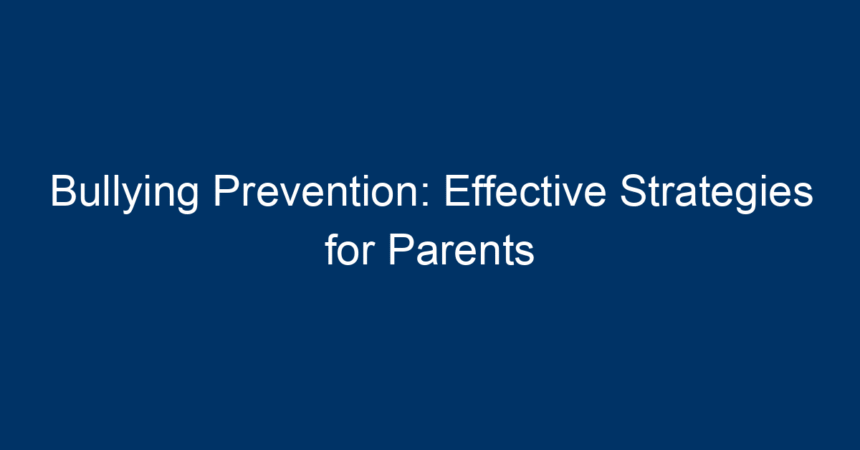Bullying is a pervasive issue that affects children and adolescents across the globe, with lasting consequences that can impact their mental health, social relationships, and academic performance. As a parent, being proactive in bullying prevention is crucial. This article explores effective strategies parents can implement to protect their children from bullying, foster a safe environment, and promote resilience.
Understanding Bullying: The Basics
Before delving into strategies, it’s essential to understand what bullying entails. Bullying typically involves repeated aggressive behavior, whether physical, verbal, or relational. Forms of bullying include:
- Physical Bullying: Hitting, kicking, or any form of physical aggression.
- Verbal Bullying: Name-calling, teasing, or making threats.
- Social Bullying: Excluding someone from a group, spreading rumors, or public humiliation.
- Cyberbullying: Using online platforms to harass, intimidate, or humiliate others.
Recognizing these forms of bullying is the first step in effective bullying prevention.
Open Communication: Building Trust with Your Child
Establish a Safe Space
Creating a trusting environment starts with open communication. Encourage your child to share their feelings and experiences without fear of judgment. Regularly check in with them about their day, friendships, and any challenges they’re facing.
Active Listening
When your child discusses their experiences, practice active listening. Show empathy and understanding, validating their feelings. This not only strengthens your bond but also empowers your child to speak up about bullying or any concerns they may have.
Teaching Empathy and Resilience
The Importance of Empathy
Teach your child the importance of empathy. Discuss the feelings of others and why understanding them is vital. Engage in activities that foster compassion, such as volunteering or helping community members.
Building Resilience
Resilience is crucial for bullying prevention. Teach your child problem-solving skills and coping mechanisms to handle difficult situations. Encourage them to develop a growth mindset, where challenges are viewed as opportunities for personal development.
Setting Clear Boundaries
Define Acceptable Behavior
It’s essential to establish clear rules regarding behavior, both at home and in school settings. Discuss the difference between friendly teasing and bullying, emphasizing that any form of intimidation is unacceptable.
Role-Playing Scenarios
Role-playing can be an effective tool in teaching your child how to react when faced with bullying. Create scenarios that reflect real-life situations and practice appropriate responses. This not only prepares them but also makes them more confident in dealing with bullying when it occurs.
Collaboration with Schools
Get Involved
Active involvement in your child’s schooling can significantly contribute to bullying prevention. Attend parent-teacher meetings, participate in school events, and stay informed about school policies related to bullying.
Advocate for Policies
Familiarize yourself with your school’s anti-bullying policy. If you find that the policy lacks strong measures, collaborate with other parents and educators to advocate for improved procedures. Support initiatives that promote inclusivity and respect among students.
Encouraging Healthy Friendships
Promote Positive Relationships
Encourage your child to build friendships with peers who share similar values and interests. Teach them to recognize healthy relationships that foster support and mutual respect.
Social Skills Development
Help your child develop social skills crucial for forming healthy relationships. Activities like team sports or clubs can enhance their ability to collaborate and communicate effectively with others.
Recognizing Signs of Bullying
Red Flags to Watch For
As a parent, being vigilant is key to early detection of bullying. Watch for signs that may indicate your child is being bullied, including:
- Sudden changes in behavior or mood
- Reluctance to go to school or participate in activities
- Physical signs like unexplained bruises or injuries
- Withdrawal from friends or family
Taking Action
If you suspect that your child is being bullied, approach the situation delicately. Discuss your concerns and reassure them that it’s essential to speak up. If they’re afraid or unsure, offer your support in addressing the situation.
Empowering Your Child
Encourage Self-Advocacy
Teaching your child to advocate for themselves is vital in bullying prevention. Encourage them to speak up when they witness bullying, whether they’re the target or a bystander. Empowering them with the words to express their feelings and concerns builds confidence.
Online Safety Awareness
In today’s digital age, cyberbullying is increasingly common. Educate your child about safe online practices, including protecting their personal information and recognizing inappropriate behavior. Discuss the importance of reporting cyberbullying incidents to trusted adults.
Seeking Professional Help
Counseling Services
If your child faces ongoing bullying or struggles with the emotional fallout, consider seeking professional help. Counseling can provide them with coping tools and strategies to manage their feelings.
Open the Dialogue with School Counselors
Introduce your child to school counselors who can offer support and mediation if bullying occurs. Counselors can facilitate discussions between your child and the aggressor, fostering understanding and potential conflict resolution.
Building a Support Network
Community Engagement
Engage with your local community or join support groups focused on bullying prevention. Networking with other parents can provide you with resources and encouragement.
Connect with Local Organizations
Many organizations advocate against bullying and can offer valuable materials, workshops, and resources for parents and children alike. Collaborating with such groups can further your efforts in combating bullying.
Conclusion: Taking Action for Bullying Prevention
In conclusion, bullying prevention requires a proactive and multifaceted approach. By fostering open communication, teaching empathy, collaborating with schools, and empowering your child, you can create a supportive environment that reduces the risk of bullying. Remember, it’s crucial to stay informed and involved, ensuring your child feels safe and valued.
Actionable Insights:
- Initiate Regular Conversations: Make it a habit to check in with your child about their feelings and experiences.
- Practice Role-Playing: Engage in role-playing exercises to prepare your child for potential bullying situations.
- Be an Advocate: Work with schools and community organizations to promote effective anti-bullying policies.
- Seek Help: Don’t hesitate to reach out for professional help if needed.
By implementing these strategies, you empower your child against bullying, fostering resilience, confidence, and strong interpersonal skills. Together, we can create a safer world for our children, free from the pervasive effects of bullying.




